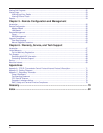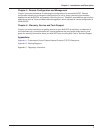
8
Chapter 1 - Introduction and Description
MultiVOIP Application
A typical Voice Over IP (VOIP) network is shown in Figure 1-2 with a headquarters site and three
remote sites (Sales office, regional and marketing offices). This typical Voice Over IP network can be
set up via the Internet or your Intranet. The headquarters site is set up with a 8-channel MultiVOIP
(MVP 800) connected to the headquarters LAN and eight voice/fax channels connected to the in-
house telephone switch (PBX), only 4-channels are shown in Figure 1-2. Typically, the MultiVOIP at
the headquarters site would be set up as the host unit. The host unit controls the phone directory
data base which is sent to each site on a periodic basis or if a new telephone number is added.
512-4123
#301
#302
Headquarters
Regional Office
Sales Office
Marketing Office
P
B
X
512-4124
512-4122
101
102
103
104
PSTN
PSTN
201
202
(5127)
522-5124
522-5123
201.23.122.118
205.24.123.119
206.25.124.120
207.26.125.121
P
B
X
PSTN
401
402
532-6128
532-6129
Internet/
Intranet
E&M Interface
FXS Interface
E&M Interface
9
10
KTS
522-5125
FXS
FXO
7
6
5
4
Figure 1-2. Example of a MultiVOIP application
The sales office is set up with a two voice/fax channel MultiVOIP series connected to the IP network
and one voice/fax channel connected directly to the local Public Switch Telephone Network (PSTN).
The second voice/fax channel is connected to the trunk side of a Key Telephone System (KTS). This
allows an attendent to direct an incoming call to one of the two telephone extensions or to the fax
machine.
The regional office is set up with two analog telephones connected directly to a two voice/fax channel
MultiVOIP. This allows a person in the corporate office to dial out thru the MultiVOIP 800 at the
corporate office and call directly into the person at extension 301.
The MultiVOIP at the marketing office is set up on the trunk side of the PBX (E&M interface) so that
you could dial into the marketing office, seize a trunk, then dial an outside line to make a local call or
connect directly to a telephone extension on the PBX or in this case to the fax machine at extension
6129.
A phone directory database is maintained on one of the MultiVOIPs which is configured as a “host”.
This phone directory is retrieved by the remaining “client” MultiVOIPs on your Voice Over IP network.
Each phone number entry corresponds to a MultiVOIP IP address and associated voice/fax channel
number. With this system, you need only update the “host” phone directory when deploying
additional MultiVOIPs to your Voice Over IP network.


















